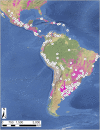Crop damage by vertebrates in Latin America: current knowledge and potential future management directions
- PMID: 35356474
- PMCID: PMC8958972
- DOI: 10.7717/peerj.13185
Crop damage by vertebrates in Latin America: current knowledge and potential future management directions
Abstract
Background: Crop farming contributes to one of the most extensive land use activities in the world, and cropland areas continue to rise. Many vertebrate species feed on crops, which has caused an increase in human-wildlife conflicts in croplands. Crop-feeding damages the economy of local communities and causes retaliation against the responsible vertebrates in several forms, including lethal practices such as hunting and poisoning. Lethal control may cause the local extirpation of some species, affecting ecological processes and patterns. Therefore, it is necessary to find non-lethal alternatives that can protect both local economies and wildlife. Research has been conducted in Africa and Asia, focusing on elephants and primates, and the effectiveness of some non-lethal alternatives, such as chili-based repellents and beehives, is being investigated. However, there has been very little research on this topic in Central and South America. The goal of this review is to assess the current knowledge on crop damage by vertebrates in Central and South America and indicate future research directions.
Survey methodology: We reviewed the available scientific literature reporting crop damage by vertebrates in Central and South America, and the Caribbean, published between 1980 and 2020, through systematic searches on Web of Science, Scopus, and Google Scholar. We analyzed the temporal and geographical distributions of the studies, the crops and vertebrate species these studies considered, the crop protection techniques used, and their effectiveness.
Results: We retrieved only 113 studies on crop damage by vertebrates in Latin America, but there was an increasing trend in the number of studies published over time. Most of the studies were conducted in Brazil, Argentina, Mexico, and Costa Rica. Four orders of mammals (Rodentia, Carnivora, Artiodactyla, and Primates) and four orders of birds (Passeriformes, Columbiformes, Psittaciformes, and Anseriformes) were the most common groups of crop-feeding vertebrates. The most prominent crop was corn, which was featured in 49% of the studies. Other notable crops include rice, sorghum, and sugarcane. The most reported method for protecting crops was lethal control through hunting or poisoning. Non-lethal techniques were found to be less prevalent. Less than half of the studies that mentioned the use of protection techniques indicated their effectiveness, and only 10 studies evaluated it by performing scientific experiments and reporting their results.
Conclusions: Central and South America is still underrepresented in research on vertebrate crop-feeding. There is a need for experimentation-based robust research to find crop protection techniques that minimize harm to vertebrates while effectively reducing damage to crops. While this is being studied, habitat loss and fragmentation need to be halted to prevent the native vertebrates from turning to crops for food.
Keywords: Agri-environment schemes; Animal damage; Bird damage; Crop feeding; Crop protection; Human-wildlife conflict; Mammal damage.
© 2022 Alejandro Cuesta Hermira and Michalski.
Conflict of interest statement
Fernanda Michalski is a research associate from Pro-Carnivores Institute. The authors declare that they have no competing interests.
Figures






Similar articles
-
Use of wild vertebrates for consumption and bushmeat trade in Brazil: a review.J Ethnobiol Ethnomed. 2023 Dec 19;19(1):64. doi: 10.1186/s13002-023-00628-x. J Ethnobiol Ethnomed. 2023. PMID: 38111028 Free PMC article. Review.
-
Wildlife uses and hunting patterns in rural communities of the Yucatan Peninsula, Mexico.J Ethnobiol Ethnomed. 2012 Oct 2;8:38. doi: 10.1186/1746-4269-8-38. J Ethnobiol Ethnomed. 2012. PMID: 23031274 Free PMC article.
-
Campesino hunting and conservation in Latin America.Conserv Biol. 2020 Apr;34(2):338-353. doi: 10.1111/cobi.13396. Epub 2019 Sep 19. Conserv Biol. 2020. PMID: 31334895 Review.
-
Spatio-temporal patterns of human-wildlife conflicts and effectiveness of mitigation in Shuklaphanta National Park, Nepal.PLoS One. 2023 Apr 17;18(4):e0282654. doi: 10.1371/journal.pone.0282654. eCollection 2023. PLoS One. 2023. PMID: 37068090 Free PMC article.
-
Agriculture and herbivorous waterfowl: a review of the scientific basis for improved management.Biol Rev Camb Philos Soc. 2017 May;92(2):854-877. doi: 10.1111/brv.12258. Epub 2016 Mar 4. Biol Rev Camb Philos Soc. 2017. PMID: 26946181 Review.
Cited by
-
The impact of land use change on mycorrhizal fungi and their associations with rodents: insights from a temperate forest in Mexico.Mycorrhiza. 2025 May 8;35(3):36. doi: 10.1007/s00572-025-01210-x. Mycorrhiza. 2025. PMID: 40338382 Free PMC article.
-
Patterns of primates crop foraging and the impacts on incomes of smallholders across the mosaic agricultural landscape of Wolaita zone, southern Ethiopia.PLoS One. 2024 Nov 18;19(11):e0313831. doi: 10.1371/journal.pone.0313831. eCollection 2024. PLoS One. 2024. PMID: 39556545 Free PMC article.
References
-
- Abrahams MI, Peres CA, Costa HCM. Manioc losses by terrestrial vertebrates in western Brazilian Amazonia. The Journal of Wildlife Management. 2018;82(4):734–746. doi: 10.1002/jwmg.21443. - DOI
-
- Álamo Iriarte AP, Sartor PD, Bernardos JN. Agriculture in semiarid ecosystems favors the increase fossorial rodent’s activity in La Pampa. Argentina European Journal of Wildlife Research. 2019;65(3):47. doi: 10.1007/s10344-019-1281-7. - DOI
-
- Albarracín V, Aliaga-Rossel E. Bearly guilty: understanding human-Andean bear conflict regarding crop losses. Ethnobiology Letters. 2018;9(2):323–332. doi: 10.14237/ebl.9.2.2018.1300. - DOI
-
- Anderson A, Lindell CA, Moxcey KM, Siemer WF, Linz GM, Curtis PD, Carroll JE, Burrows CL, Boulanger JR, Steensma KMM, Shwiff SA. Bird damage to select fruit crops: the cost of damage and the benefits of control in five states. Crop Protection. 2013;52(1):103–109. doi: 10.1016/j.cropro.2013.05.019. - DOI
Publication types
MeSH terms
LinkOut - more resources
Full Text Sources

